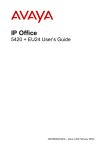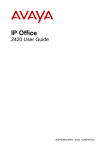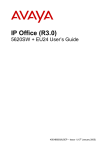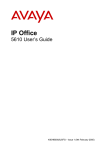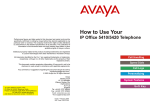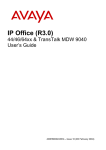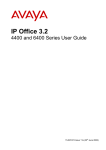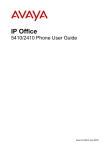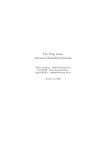Download avaya 4620 manual
Transcript
For bulk discounts, product demonstrations, free product trials & world-wide Avaya orders, please contact: Telefonix Voice & Data UK (+44) 01252 333 888 [email protected] http://www.telefonix.co.uk/ Avaya 9620 Manual For the latest information about the Avaya 9620, please visit: http://www.telefonix.co.uk/avaya-9620/ 40DHB0002USEP - I The 4620 Telephone Page ii Contents The 4620 IP Telephone ............ 4 To Delete an Individual Log Entry ................22 To Turn a Log Entry into a Speed Dial.........22 Overview of the 4620 ................................... 4 Call Appearance Keys.................................. 6 Web Browsing.........................23 Call Handling ............................ 7 Answer Incoming Calls................................. 7 Make a Call .................................................. 7 Speakerphone.............................................. 7 Mute ............................................................. 8 Hold.............................................................. 8 Transfer........................................................ 9 Conference .................................................. 9 4620 IP Telephone Options ... 10 Telephone Options Overview..................... 10 Application Option...................................... 11 Personalizing Redial .................................... 11 Phone Screen on Answer ............................ 11 Phone Screen on Calling ............................. 11 Display Call Timers...................................... 11 Message Display Rate................................. 12 Call Appearance Width ................................ 12 Visual Alerting .............................................. 12 Call Log........................................................ 12 Personal Ringing Options .......................... 13 Viewing the Status Screen ......................... 13 IP Address Settings ..................................... 13 Quality of Service (QoS) Information........... 13 Phone Interface ........................................... 13 Miscellaneous Information ........................... 14 Contrast Control......................................... 14 Logging off the 4620 IP Phone................... 14 Reinstating the Phone ................................. 15 Backup/Restore Options ............................ 15 Feature Button Labeling............................. 15 Display Language Selection....................... 16 Speed Dials............................. 17 Overview of Speed Dials............................ 17 Using Speed Dials ..................................... 18 Accessing the Speed Dial Directory/Dialing a Speed Dial..................... 18 Adding a Speed Dial from the Call Log ....... 18 Editing a Speed Dial .................................... 18 Deleting a Speed Dial .................................. 18 Adding a New Speed Dial............................ 19 Using the Call Log ................. 20 Overview of the Call Log ............................ 20 Using the Call Logs .................................... 21 To Access the Call Logs .............................. 21 To Delete All Entries from a Log.................. 21 To Exit the Call Logs.................................... 21 Using Individual Log Entries....................... 22 To Display an Individual Log Entry .............. 22 4620 User’s Guide IP Office Overview of Web Browsing........................ 23 Accessing External WAP Websites ........... 23 Web Navigation Controls ........................... 24 Entering Data............................................. 25 Function Keys.........................26 Overview of Function Keys ........................ 26 Functions ................................................... 26 Absnt - Set Absent Text ...............................26 Acct - Account Code Entry ...........................26 AD - Abbreviated Dial...................................26 Apear - Appearance .....................................26 AutCB - Automatic Callback.........................26 Cfrwd - Call Forwarding All ..........................27 CPark - Call Park..........................................27 CPkUp - Call Pickup.....................................27 CWOn - Call Waiting On ..............................27 ClrCW - Clear CW ........................................27 Conf+ - Conference Add ..............................28 Drop - Drop...................................................28 DpkUp - Directed Call Pickup.......................28 DCW - Dial CW ............................................28 Dirct - Dial Direct ..........................................28 DNDOn - Do Not Disturb On ........................28 DNDX+ - Do Not Disturb Exception Add......29 DNDX- - Do Not Disturb Exception Delete ...........................................................29 Emrgy - Dial Emergency ..............................29 FwdOf - Cancel All Forwarding ....................29 FwNOn - Forward On No Answer On ..........29 FwBOn - Forward On Busy On ....................29 FolTo - Follow Me To ...................................29 FwUOn - Forward Unconditional On ............30 FwdNo - Forward Number............................30 FwdH+ - Forward Hunt Group Calls On.......30 GrpPg - Group Paging .................................30 HfAns - Internal Auto-Answer.......................30 HdSet - Headset Toggle...............................30 Here- - Follow Me Here Cancel....................30 Here+ - Follow Me Here ...............................31 HGNS+ - Set Hunt Group Night Service ......31 HGNS- - Clear Hunt Group Night Service....31 HGOS+ - Set Hunt Group Out of Service ....31 HGOS- - Clear Hunt Group Out of Service .........................................................31 HGEna - Hunt Group Enable .......................31 HGDis - Hunt Group Disable........................31 HoldCW - Hold Call Waiting .........................32 IAuto - Automatic Intercom...........................32 IDial - Dial Intercom......................................32 Intru - Call Intrude.........................................32 Login - Extn Login ........................................32 Logof - Extn Logout ......................................32 Music - Hold Music .......................................32 NATim - Set No Answer Time ......................33 Park - Call Park to Other Extension .............33 Page ii 40DHB0002USEP - Issue 1 (4th November 2003) The 4620 Telephone Page iii PickA - Call Pickup Any ............................... 33 PickG - Call Pickup Group ........................... 33 PickM - Call Pickup Members...................... 33 Queue - Call Queue..................................... 33 Recor - Call Record ..................................... 34 RngOf - Ringer Off....................................... 34 Relay - Relay Pulse ..................................... 34 Rely+ - Relay On ......................................... 34 Rely- - Relay Off .......................................... 34 SAC - Send All Calls.................................... 34 Steal - Call Steal .......................................... 35 SusCW - Suspend CW ................................ 35 TmDay - Time of Day................................... 35 VMRB+ - Voicemail Ringback On................ 35 VMCol - Voicemail Collect ........................... 35 VMOn - Voicemail On .................................. 35 WUTim - Set Wrap Up Time ........................ 35 Management and Troubleshooting .................... 36 Overview .................................................... 36 Testing your phone .................................... 36 Testing the Telephone's Lights and Display ......................................................... 36 Troubleshooting Chart................................ 36 Resetting the IP Telephone........................ 40 Resetting Your Phone.................................. 40 Power Cycling Your Phone.......................... 41 Index........................................ 42 4620 User’s Guide IP Office Page iii 40DHB0002USEP - Issue 1 (4th November 2003) The 4620 Telephone Page 4 The 4620 IP Telephone Overview of the 4620 This guide covers the use of the Avaya 4620 telephone on Avaya IP Office telephone systems. The diagram below shows the face of the 4620 telephone and contains numbered “callouts”, which identify the phone’s primary features and buttons. Each callout is described in detail in Table 1.1, which follows the diagram. Figure 1-1: 4620 IP Telephone Table 1-1: 4620 IP Telephone Button/Feature Descriptions Callout Number 1 2 3 4 5 4620 User’s Guide IP Office Button/Feature Name Message waiting lamp Button/Feature Description Lit continuously when the user has voicemail messages waiting. Can also be set to flash when the phone is ringing. Information displayed varies according Display screen to the application/function currently active. When someone is calling in, the name/phone number of that person displays here. Twelve Call Appearance/Feature Call Appearance/Feature buttons provide both call appearance (incoming and outgoing calls) and buttons application specific functionality. Used to navigate to or initiate certain Softkeys features, such as Speed Dial or Call Log, as well as control certain actions within the features. These keys correspond to the text prompts in the display screen immediately above them. Displays the phone application main Phone/Exit screen or, if applicable, exits the current IP Office based feature, such as Speed Dial or Call Log, and normalizes the display. Page 4 40DHB0002USEP - Issue 1 (4th November 2003) The 4620 Telephone Page 5 6 Options 7 Page Right/Left 8 11 Speaker LED Indicator Speaker Headset LED Indicator Headset 12 Mute LED Indicator 13 Mute 14 Volume Control 15 Headset Jack 16 17 18 Hold Transfer Conference 19 Drop 20 Redial 21 Numeric (Dialing) Pad 9 10 4620 User’s Guide IP Office Displays the Options main screen, from which display and application settings can be updated. Shifts from one page to another in the same application, when the display presents the paging indicator ( ). These buttons have no effect when the paging indicator is not displayed. Lights steadily when the Speakerphone is active. Accesses the Speakerphone feature. Lights steadily when the headset is active. With a headset connected, changes audio control from the handset or speaker to the headset. Lights steadily when the handset or headset is muted. Turns off the active Speakerphone, handset, or headset microphone, to prevent the other person from hearing you. Adjusts the handset, speaker, headset, or ringer volume, depending on which item is in use. As you increase or decrease the volume, the top display area provides either a speaker, headset, handset, or ringer icon to indicate for which item you are adjusting volume, followed by a visual “volume meter” showing the volume level. These buttons also control the volume of the key click sounds made when you press fixed buttons on the phone, such as the dialpad or softkeys. Provides a port for connecting a headset on the underside of the phone. Red button used to place a call on hold. Transfers a call to another phone. Sets up conference calls with more than one other person. Drops the current line on which the Drop button is pressed. Redials the last number dialed or displays the last 6 numbers dialed from the phone, depending on configuration via the Options menu. Standard 12 button pad for dialing phone numbers. Page 5 40DHB0002USEP - Issue 1 (4th November 2003) The 4620 Telephone Page 6 Call Appearance Keys The default first page of the main call screen contains three keys set as ‘call appearance’ keys. These keys show that the 4620 is a multi-line phone and are indicated as a=, b= and c=. Note: The number of call appearance keys can vary and the descriptive text shown next to the key when idle can be changed. Call appearance must be assigned sequentially starting with the first call appearance/feature key. The call appearance keys also indicate the status of calls as you are toggling between calls. If you are set to receive call waiting indication, the waiting call is shown against the next call appearance key. If you then choose to pick up the waiting call, the status of the current call will change. These are the call status symbols that can appear in the call appearance key: 4620 User’s Guide IP Office • Incoming Call: A symbol next to a call appearance key indicates an incoming call. The caller’s telephone number (if available) is also shown. Pressing the adjacent key answers the call and puts any current call on hold. • Connected: A symbol next to a call appearance key indicates that it is the currently connected call. The caller’s telephone number (if available) is also shown. Pressing the adjacent key puts the call on hold. • On Hold: A symbol next to the call appearance key indicates a call on hold. Pressing the adjacent key takes the call off hold and puts any other current call on hold. Page 6 40DHB0002USEP - Issue 1 (4th November 2003) The 4620 Telephone Page 7 Call Handling Answer Incoming Calls When there is an incoming call, you will hear a ringing tone and a blinking bell icon appears on the associated call appearance screen. To answer an incoming call, do one of the following: Answering the first incoming call 1. Pick up the handset or press the speakerphone. button to use the Answering waiting calls If you have call waiting switched on, the waiting call is shown against the next call appearance key and a tone is played to further indicate the waiting call. If you choose to answer the waiting call, press the button corresponding to waiting call and the current call will be placed on hold. Make a Call There are several options for making a phone call, depending on what how you want to use the phone. Making a call using the handset 1. Pick up the handset. 2. Dial the phone number of the person you want to contact, including any outside line digits and/or area codes. Making a call using speakerphone 1. Press . 2. Dial the phone number of the person you want to contact, including any outside line digits and/or area codes. See “Speakerphone” for more information on using the speakerphone. Making a call using speed dial See “Using Speed Dials”. Speakerphone The two-way built-in speakerphone allows you to make and answer calls without lifting the handset. Keep in mind that two-way speakerphones may not operate satisfactorily in every environment (such as in very noisy locations). Using the speakerphone with any feature . 1. Press 2. Make or answer the call, or access the selected feature. 3. Adjust the speakerphone volume if necessary. 4620 User’s Guide IP Office Page 7 40DHB0002USEP - Issue 1 (4th November 2003) The 4620 Telephone Page 8 • To change the volume, use the and buttons. The display bar at the top of the display screen shows the volume level. (There are eight volume levels.) Changing from speakerphone to handset 1. Pick up the handset and continue talking. Changing from handset to speakerphone 1. Press . 2. Hang up the handset. Ending a speakerphone call 1. Press again. Mute During an active call, the Mute feature prevents the party with whom you are speaking from hearing you. This feature is most commonly used in conjunction with the Speakerphone, but can be used to hold an off-line conversation at any time during a call. Preventing the other person on the line from hearing you 1. Press Mute. • The other party cannot hear you. The indicator next to the Mute button lights when Mute is active. 2. To reinstate two-way conversation, press Mute again. Hold The Hold feature puts a call on hold until you retrieve it. Placing a call on hold Press the Hold. • The line display area changes to white text with a dark gray background, and the Hold icon displays. Retrieving the held call Press the corresponding Line/Feature button on which the call is being Hold. held, or press the • The call is now active. 4620 User’s Guide IP Office Page 8 40DHB0002USEP - Issue 1 (4th November 2003) The 4620 Telephone Page 9 Transfer The Transfer feature lets you transfer a call from your telephone to another extension or outside number. Transferring a call to another telephone 1. With the call active (or with only one held call and no active calls), Transfer. press the • The call is placed on hold; the Hold icon displays and you hear a dial tone while the next available line activates. 2. Dial the number to which you want to transfer the call. 3. If you do not want to announce the call, press the Transfer again and proceed to Step 6. If you wish to wait for an answer and announce the call, go to Step 4. • The call is sent to the extension or number you dialed. A twosecond display message indicates the transfer is complete. 4. Remain on the line and announce the call; if the line is busy or if no one answers, return to the held call by pressing the Call Appearance/Feature button on which it is being held. 5. Press Transfer again. • The call is sent to the extension or number you dialed. A twosecond display message indicates the transfer is complete. 6. Hang up your handset. Conference The number of conferences available is dependent on the IP Office unit set up on your system. Adding another party to a call 1. Dial the first party, then press Conference. • The line display area changes to white text with a dark gray background. The current call is placed on hold, the Soft Hold icon displays and you hear a dial tone. 2. Dial the number of the next party and wait for an answer. 3. Press Conference again to add the new party to the call. 4. Repeat Steps 1- 3 for each party you want to conference in to the call. Adding a held call to the current call 1. Press Conference. • The icon on the current line changes to the Soft Hold icon. 2. Press the Call Appearance/Feature button corresponding to the held call. 3. Press the Conference button again. • All parties are now connected. Dropping yourself from the conference Press the Drop button. • Disconnects the line on which the drop button is pressed. 4620 User’s Guide IP Office Page 9 40DHB0002USEP - Issue 1 (4th November 2003) The 4620 Telephone Page 10 4620 IP Telephone Options Telephone Options Overview The (Option) button will allow viewing and configuring of certain phone settings. These options are different from the function keys that require configuration by the system administrator. The phone settings available include: • Displaying the Phone screen upon answering a call • Personalizing the ringing pattern • Determining how you want the Redial feature to work (redial the last number called or select from a list of the last six calls) • Displaying the Call Timer • Changing the rate at which messages display • Changing the display area’s contrast • Logging off • Backing up and restoring Speed Dial button data, feature button labels, and options settings • Selecting a different language for the 4620 user interface • Changing the width of displayed call appearances • Allowing the Voice message light to flash when the telephone rings • Disabling and re-enabling the Call Log This chapter also covers how to verify the status of certain phone/server interactions. This information can be useful in troubleshooting problems or when discussing phone operation with your System Administrator. 4620 User’s Guide IP Office Page 10 40DHB0002USEP - Issue 1 (4th November 2003) The 4620 Telephone Page 11 Application Option Personalizing Redial Redial can be configured to dial the last number dialed or list the last six numbers dialed for you to choose from. The default is the last number dialed. To change Redial: 1. Select the corresponding Call Appearance/Feature button. It will toggle between Last Number and Last 6 Numbers. 2. Select Save. Phone Screen on Answer This action controls the phone screen display when the phone is answered. When the Phone Screen on Answer? option is set to Yes, the phone screen appears in the display area when you answer a call, regardless of the screen you were working with at that time. You will lose any unsaved work in progress on that screen (for example, labeling a Speed Dial button), except for the Web Access application (which “remembers” the current web screen). When the Phone Screen on Answer? option is set to No (the default setting), answering an incoming call has no impact on the application screen displayed, although the top display line will provide an appropriate message. To change Phone Screen on Answer: 1. Select the corresponding Call Appearance/Feature button. It will toggle between Yes and No. 2. Select Save. (To restore the previous setting without changing it, press Cancel.) After saving or canceling, the first Options Main screen displays. Phone Screen on Calling This action is not supported with the 4620 IP Telephone on Avaya IP Office System. Display Call Timers This action controls whether the duration of the current call is displayed or not. If set to Yes, the duration of the current call is displayed on the call appearance key. If set to No, the call duration will not be displayed. To change the Display Call Timers status: 1. Select the corresponding Call Appearance/Feature button. It will toggle between Yes and No. 2. Select Save. (To restore the previous setting without changing it, press Cancel.) After saving or canceling, the first Options Main screen displays. 4620 User’s Guide IP Office Page 11 40DHB0002USEP - Issue 1 (4th November 2003) The 4620 Telephone Page 12 Message Display Rate When the IP Office sends messages to your phone that are longer than the display area, the first part of the message is presented for a specific time interval. The second part of the message is then displayed for a specific time interval. The Message Display Rate can be either Fast (display interval is 2 seconds) or Slow - default (display interval is 3 seconds). To change Message Display Rate: 1. Select the corresponding Call Appearance/Feature button. This will toggle between Fast and Slow. 2. Select Save. (To restore the previous setting without changing it, press Cancel.) Upon saving, the first Options Main screen displays. Call Appearance Width When the Call Appearance Width is set to Full (the default), each line on which a call appears extends the full width of the display, and accommodates messages in the call appearance display area. When this option is set to Half, the call appearance area is limited to half of the display area and call-related messages appear on the top display line. To change Call Appearance width: 1. Select the corresponding Call Appearance/Feature button. This will toggle between Full and Half. 2. Select Save. (To restore the previous setting without changing it, press Cancel.) Upon saving or canceling, the first Options Main screen displays. Visual Alerting When this option is set to No (the default), ringing is the only notification of an incoming call. When set to Yes, your phone rings and your voice message indicator light flashes to alert you to an incoming call. To change Visual Alerting: 1. Press the corresponding Call Appearance/Feature button. To toggle between No and Yes options. 2. Select Save. (To restore the previous setting without changing it, press Cancel.) Upon saving or canceling, the first Options Main screen displays. Call Log The 4620 IP Telephone’s Call Log is a standard application that saves incoming and outgoing call log information in one of three logs: • Incoming Answered calls • Incoming Unanswered calls • Outgoing calls Having the Call Log Enabled (active) is the default, but this feature can be Disabled, to stop call logging and delete any calls currently logged. To enable/disable Call Log: 1. Select the corresponding Call Appearance/Feature button. This will toggle between Enabled and Disabled. 2. Select Save. (To restore the previous setting without changing it, press the Cancel.) Upon saving or canceling, the first Options Main screen displays. 4620 User’s Guide IP Office Page 12 40DHB0002USEP - Issue 1 (4th November 2003) The 4620 Telephone Page 13 Personal Ringing Options The 4620 IP Telephone has eight ringing pattern options. You can hear the patterns and select the preferred one by using the Personal Ringing option. Select this option from the Options Main screen, accessed by pressing the phone’s Option button. To hear a ring pattern and change the Personal Ringing options: 1. Select the corresponding Call Appearance/Feature button to the left or right of any numbered pattern. The Current Pattern number changes to the selected pattern, which rings once as a sample. 2. Repeat Step 1 until the preferred pattern appears as the Current Pattern. 3. Save the setting by pressing the Save. Upon saving or canceling, the first Options Main screen displays. NOTE: Going off-hook, receiving a call, or losing power during ring pattern selection interrupts the process, and you must start over from Step 1. Viewing the Status Screen Views of telephone and system information are available from this screen. A user normally does not need to view this information, however your System Administrator may ask you to report certain values from any of the status screens in the event of problems. The status screen data can be viewed, but cannot be changed. 1. Select View IP Settings from the Options Main screen (accessed by pressing the phone’s Option button). 2. To select any option on this screen, press the corresponding Call Appearance/Feature button. (When a screen has more than one page, the Paging Indicator displays to allow scrolling from one page to another using the Page Right/Left Indicator buttons as applicable.) 3. To return to the first Options Main screen from any status screen, press Return. Each option is described in the sub-sections that follow. IP Address Settings IP (Internet Protocol) address information identifies certain components and connections. IP Address information includes the location (address) of your phone on the IP Office unit, the location and port (connection) of the IP Office itself, the call routing and mask addresses, and the identification of the File Server with which your telephone interacts. Although technical in nature, having this information available and knowing how to get to it can assist your System Administrator in tracking questions about or problems with phone functions or connections. Quality of Service (QoS) Information QoS refers to a number of mechanisms used to improve audio quality over the network. Phone Interface Your phone interfaces with several system hardware devices and software. This screen provides information about three of the main interfaces. 4620 User’s Guide IP Office Page 13 40DHB0002USEP - Issue 1 (4th November 2003) The 4620 Telephone Page 14 Miscellaneous Information The miscellaneous status screens provide additional information about your telephone and its connections. Contrast Control On first-time startup, the 4620 IP Telephone’s display area contrast is set to a mid-level. Should you need to adjust it to better suit your work environment and lighting, 15 contrast levels are available. NOTE: You may not be able to distinguish between all 15 contrast level settings. Some of the upper and/or some of the lower contrast level settings may appear identical to adjacent settings. This is normal. To adjust the contrast level: 1. Select the Contrast Control option from the Options Main screen (accessed by pressing the phone’s Option button). 2. To adjust the contrast, press corresponding to the Right Arrow/Left Arrow until you reach the desired contrast level. ( symbols provide visual confirmation of the current level.) 3. Save the contrast level you set by pressing the Save, or, to restore the previous setting without changing the contrast, press the Cancel. The first Options Main screen displays after saving or canceling. Logging off the 4620 IP Phone Log your telephone off to prevent unauthorized use during an absence, or for privacy purposes. The Logoff function is accessed by selecting the Options button. CAUTION: Logging off deletes all Call Log entries and returns any options you may have changed to their default values. To log your phone off: 1. Select the Call Appearance/Feature button corresponding to the Log Off option. 2. To proceed with the log off, select the Call Appearance/Feature button corresponding to Yes. To return to the Options Main screen without logging off, select the Call Appearance/Feature corresponding to No. Selecting Yes un-registers your phone from the IP Office, deletes all Call Log entries and returns any options you may have configured to their default values. Selecting No displays the first Options Main screen; your phone remains logged on to the network and your Call Log and options values remain unchanged. 4620 User’s Guide IP Office Page 14 40DHB0002USEP - Issue 1 (4th November 2003) The 4620 Telephone Page 15 Reinstating the Phone When your phone is logged off, the top line displays “Extension=*.” To reinstate your phone following a log off: 1. The telephone screen displays your extension number. Press the Hash (#) key. If the screen does not display your extension number, use the dialpad to enter the number, then press the Hash (#) key. 2. The display prompts for entry of your password. Using the dialpad, enter your PBX/switch Password then press the Hash(#) key. If a password was set by the System Administrator, enter any number and press Hash (#). The phone is now ready for use. Backup/Restore Options The 4620 IP Telephone’s backup/restore options require set up and configuration by the system administrator prior to use. These options are displayed on the telephone screen via the Options button, but will only be amendable if they have been configured by the system administrator. The backup/restore options provide the ability to: • Back up your options/preference settings and your Speed Dial button labels, names, and numbers automatically whenever you save a change to any one of those settings or buttons. Automatic backup protects this data against system failure, by allowing you to restore your backup file of active settings and button labels. • Restore options settings and Speed Dial button labels, names and numbers following a phone failure or replacement. • Establish or modify FTP (File Transfer Protocol) settings such as the network server address, directory path for saving backed-up data, and a User ID and Password for server access via your phone. • Verify whether an automatic backup has occurred. Because each telephone system has unique characteristics and settings, modifying the Backup/Restore options generally require the assistance of the System Administrator. For example, it is unlikely that a 4620 IP Telephone user would know the specific Server IP Address to enter when setting up FTP parameters without consulting his or her System Administrator. Due to the technical nature of this feature, it is highly recommended that you consult with the system administrator before making any configuration changes. Feature Button Labeling This action is not supported with the 4620 IP Telephone on Avaya IP Office System. 4620 User’s Guide IP Office Page 15 40DHB0002USEP - Issue 1 (4th November 2003) The 4620 Telephone Page 16 Display Language Selection Non-English speaking users can change the user interface language displayed on their 4620 IP Telephones. This language selection feature is accessible via the Options button. Language options are: • English (the default display language) • Français • Italiano • Japanese • Español • Deutsche • Nederlands • Português To select a language: 1. Select Select display language on the second Options Main screen. The Language Selection screen displays. corresponding to the language you want your 2. Select the phone to display when in use. • If the currently active language is selected, the second Options Main screen re-displays and no action is taken. • If any language other than the currently active language is selected, the Language Confirmation screen displays prompting “Are you sure?” in the currently active language and in the new language you selected. • The four at the bottom of the display are labeled respectively, Yes and No in both the currently active language and the selected new language. 3. Choose Yes or No in either language. • Yes selection: The active language changes to the new language you selected. The second Options Main screen redisplays. All screens now display the new user interface language. • No selection: The language remains unchanged and the language selection screen redisplays. Repeat the procedure from Step 2 to select a different language, or select Return to return to the second Options Main screen. 4620 User’s Guide IP Office Page 16 40DHB0002USEP - Issue 1 (4th November 2003) The 4620 Telephone Page 17 Speed Dials Overview of Speed Dials The 4620 can store up to 108 personal speed dials, accessed by selecting SpDial on the display. • • • The speed dials are sorted alphabetically. Pressing the or key adjacent to an name, dials the speed dial number stored with that name. The symbol indicates that there are more pages. You can more Page Left and Page Right keys. between pages using the Add allows you to add a new speed dial. You can also press Pressing Edit and an existing speed dial to edit its current settings. • 4620 User’s Guide IP Office Note: Speed dials can be used for any numbers that can be manually dialed from the extension. If for external calls, a dialing prefix is required; that prefix must be part of the speed dial number. Page 17 40DHB0002USEP - Issue 1 (4th November 2003) The 4620 Telephone Page 18 Using Speed Dials Accessing the Speed Dial Directory/Dialing a Speed Dial Note: You can use the speed dial directory to make a call with the handset on hook or off hook. SpDial to display the speed dial directory. 1. Press • Phone Exit to If SpDial is not shown, you may have to press exit the current screen function. 2. The symbol is shown if there is more than one page of speed dials. You can more between pages using the Page Left and Page Right keys. 3. When the speed dial required is shown on the screen, press the or key adjacent to the speed dial name. 4. Continue as per a normal call. Adding a Speed Dial from the Call Log You can create a new speed dial from a call log entry. See "To Turn a Log Entry into a Speed Dial". This process will start the normal speed entry screen but pre-filled with the name and number from the call log entry. Editing a Speed Dial 1. Access the speed dial directory ( SpDial) (see "Accessing the Speed Dial Directory/Dialing a Speed Dial" on page 18). 2. Go to the page containing the speed dial to edit ( Page Left and Page Right) 3. Press Edit. or key next to the speed dial to edit. 4. Press the The editing process is similar to adding a new speed dial, see "Adding a New Speed Dial “on page 19. • When editing an existing speed dial, a Delete option is provided to remove the speed dial from the speed dial directory. When selected press Delete to confirm or Cancel to exit without deleting. Deleting a Speed Dial 1. Access the speed dial directory ( SpDial) (see "Accessing the Speed Dial Directory/Dialing a Speed Dial" on page 18). 2. Go to the page containing the speed dial to edit ( Page Left and Page Right). 3. Press Delete. 4. Press the or key next to the speed dial to delete. Delete to confirm the deletion. Press Cancel to exit 5. Press without deleting. 4620 User’s Guide IP Office Page 18 40DHB0002USEP - Issue 1 (4th November 2003) The 4620 Telephone Page 19 Adding a New Speed Dial 1. Access the speed dial directory (see "Accessing the Speed Dial Directory/Dialing a Speed Dial" on page 18). 2. Press Add. 3. The cursor, a symbol, in initially in the empty name field. You can move between Name and Number entry by pressing the adjacent key. 4. Begin entering text using the telephone keypad. Each key is marked with the letters it provides. You may have to press the key more than once depending on the character you require. • For example, the 2 key is also marked as A, B and C. To enter a C press the key until a C is displayed. • If the next character you want to enter is on the same key, press and then enter the next character. 5. As you enter characters you can use a number of other controls. Note: The controls on this screen are context sensitive, ie. they only appear when applicable. For example Save only appears when a name and number have been entered. • Save - Save the speed dial changes. - Moves the cursor left one character. • - Moves the cursor right one character. • • Cancel - Return back to the speed dial directory without making any changes. • Clear - Delete the whole name or number entry. Case - Change the case of the current character between upper • and lower case. • Backspace - Delete the character before the cursor. Apostrophe - Insert an apostrophe (') symbol. • Comma - Insert a comma (,) symbol. • Space - Insert a space. • 4620 User’s Guide IP Office Page 19 40DHB0002USEP - Issue 1 (4th November 2003) The 4620 Telephone Page 20 Using the Call Log Overview of the Call Log The 4620 maintains a call log, accessed by selecting Log on the display. The call logs keeps logs of missed calls, outgoing calls made and incoming calls answered. Each of these logs includes the 30 most recent calls in its category. The details shown are: • • • • • The name of the called or calling party if available. The number of the called or calling party. The time of the call. The date of the call if prior to the current day. symbol indicates that the log contain more pages of entries. You The Page Left and Page Right can more between pages using the keys. Pressing the or key adjacent to a log entry displays full details of that log entry: Each individual log entry includes: • • • • • The name of the called or calling party if available. The number of the called or calling party. The time of the call. The date of the call. The duration of the call for outgoing and answered calls. Apart from using the call logs for information, you can turn a call log entry into a speed dial for future calls. You can also delete individual log entries or the all entries in a particular log. Note: Call log entries are lost whenever the telephone system or the individual 4620 telephone are reset. 4620 User’s Guide IP Office Page 20 40DHB0002USEP - Issue 1 (4th November 2003) The 4620 Telephone Page 21 Using the Call Logs To Access the Call Logs 1. Press the key under Log. • Phone Exit to exit If Log is not shown, you may have to press the current screen function. 2. The call log always opens in the Missed calls log. 3. To select the log required press the key under Missed, InAns or Outgo. • Missed: The log of missed calls, ie. those that rang your extension but were not answered. This includes calls that were diverted to voicemail or another number after ringing your extension. • InAns: The log of incoming calls that were answered. This includes both internal and external calls. • Outgo: The log of calls made. This includes both internal and external calls. 4. If the selected log contains more than one page of entries, the is shown. Use the Page Left and Page Right keys to move between pages. To Delete All Entries from a Log 1. Press Missed, InAns or Outgo to select the log. key under DeleteAll. 2. Press the 3. Select Delete to delete the log entries. Press Cancel to return to the call log without deleting the log entries. To Exit the Call Logs 1. Press 4620 User’s Guide IP Office Phone Exit. Page 21 40DHB0002USEP - Issue 1 (4th November 2003) The 4620 Telephone Page 22 Using Individual Log Entries Each call log entry can be viewed individually. You can then delete the entry or use it to add a new speed dial. To Display an Individual Log Entry 1. 2. 3. 4. Locate the log entry in which you are interested. Press the or key adjacent to the entry. The log entry details are shown. Using Return key to return to the call log. To Delete an Individual Log Entry 1. Locate the log entry and press the or key adjacent to it. 2. Press Delete. 3. Press Delete to delete the log entry. Press Cancel to return to the call log without deleting the log entry. 4. You will be returned to the call log. To Turn a Log Entry into a Speed Dial 1. Locate the log entry and press the or key adjacent to it. 2. Press Add to SD. 3. The screen for editing and adding speed dials will appear, prefilled with the information from the log entry. Edit the details if required and press Save or Cancel. 4. You will be returned to the speed dials selection menu. 4620 User’s Guide IP Office Page 22 40DHB0002USEP - Issue 1 (4th November 2003) The 4620 Telephone Page 23 Web Browsing Overview of Web Browsing The 4620 can act as a web browser for WAP (Wireless Application Protocol) web sites. These web sites contain pages written in a language called WML (Wireless Markup Language). The 4620 supports WML1.2. If your telephone system has been setup with a default WAP website, the 4620 will display Web. Pressing this key will display your systems default WAP website. The links and services on this site will control the WAP website and services you can access. While browsing, you can still make and receive calls. But if you have Phone Screen on Answer option set to Yes and you answer an incoming call, the default phone screen will replace the existing web page in the display area. To enter web browsing mode: key under Web. 1. Press the To exit web browsing mode: 1. Press Phone Exit. Phone Exit is pressed while browsing the web, the last web page If viewed will be displayed when Web is pressed again before a system reboot. Accessing External WAP Websites Your default WAP web site may contain a page where you can select or enter the URL of external WAP websites. If this is the case, you should be aware that some website may contain information that the 4620 is not able to display. If the WAP web page uses WML features that the 4620 does not support, those features will not be shown. If the WAP web page uses features that the 4620 does not recognize as valid WML 1.2, the 4620 will display Not a valid WML page. 4620 User’s Guide IP Office Page 23 40DHB0002USEP - Issue 1 (4th November 2003) The 4620 Telephone Page 24 Web Navigation Controls Having pressed display Web to access your default WAP website, the 4620 display shows a number of navigation controls. 4620 User’s Guide IP Office • Navigation Icon Buttons: These appear on the right-hand side of the web display. Note that they may appear grayed out when not useable. Up Page: Press the adjacent key to move up the page by one screen (six lines) Up Line: Press the adjacent key to move up the page by one line. Home: Press the adjacent key to return to the default WAP website's home page. Refresh: Press the adjacent key to reload the current page. If you had already selected another page to load this will cancel the loading of that page and reload the current page. Down Line: Press the adjacent key to move down the page by one line Down Page: Press the adjacent key to move down the page by • Link Buttons: The keys at the left hand edge of the screen are used to select links within the displayed web page. Links are indicated by underlined text. Only one link will appear on a line and pressing the adjacent key will activate that link. • Page Buttons: The keys across the base of the web display may be used to provide labeled links to other pages. If there are more than 3 such links, the right-hand key will be labeled as More, press this key to display the additional options. • Phone Icon: If the icon appears next to a link in the web page, it indicates that the link is a telephone number. Pressing the adjacent key to select the link will dial the number. Page 24 40DHB0002USEP - Issue 1 (4th November 2003) The 4620 Telephone Page 25 Entering Data Some web pages may require you to enter data into a text field and then submit that data. For example, if you browse to a search engine web site like Google, you may be asked to enter a search field. • : Option (Radio Buttons) These allow you to select an option from a list by clicking on the adjacent left-hand key. The selected option appears as . • : Text Entry Fields These normally appear as [Enter text here] or pre-filled with some data. Submit Buttons Text entry and option key selections are not completed until submitted. Normally this will be done by a link, using a or key, labeled as Submit or similar. The exact appearance will vary between different web pages. • To enter text into a [ ] text entry field: 1. Press the left-hand key adjacent to the [ ] text entry field. 2. The four keys at the bottom of the screen change to DONE, BKSP, SPACE and alpha. • DONE: Press this key when your text entry is complete. to key delete the previous character. • BKSP: Press this key to add a space. • SPACE: Press this • alpha: This indicates the current text entry mode (in this example key to select a different text entry lower-case letters). Press the mode. 3. Begin entering text using the telephone keypad. Each key is marked with the letters it provides. You may have to press the key more than once depending on the character you require. • For example, the 2 key is also marked as A, B and C. To enter a C press the key three times. • If the next character you want to enter is on the same key, press 1 and then enter the next character. 4. The right-most key indicates the current text entry mode. To change the current mode, press the right-hand key. The available modes are shown along the bottom of the screen. They are: • ALPHA: Enter upper-case letters using the telephone keypad. • alpha: Enter lower-case letters using the telephone keypad. • Num: Enter numbers using the telephone keypad. • Symbol: Enter a symbol from the displayed menu. Possible symbols are: . , # @ * ' " ; : \ / – | $ % ! ? & + = > < ( ) ~ _ ^ [ ] { }. These are arranged in pages and you may have to press MORE to select the required page. To enter a symbol, press the key next to it. 5. When you have completed your text entry, press DONE . 6. You can return to text entry by pressing the left-hand key adjacent to the [ ] text entry field again. 4620 User’s Guide IP Office Page 25 40DHB0002USEP - Issue 1 (4th November 2003) The 4620 Telephone Page 26 Function Keys Overview of Function Keys Function keys enable personalization of the 4620 IP telephone. Functions listed in this section are available only if the system administrator has programmed them. If programmed, the function’s abbreviated names will appear on the telephone display menu corresponding to and . Functions This section lists the programmable functions available on the 4620 IP telephone. Absnt - Set Absent Text Enables users to set an absent statement which appears in the callers’ Tab Field, e.g. Out of office until Thursday. Acct - Account Code Entry Account codes are used to track numbers dialed from the phone. If programmed with data, the account code entered when programmed must match a valid account code set on the telephone system. The Acct key displays that number. If programmed without data, ENTER ACCOUNT is displayed after Acct is pressed. Enter an account code and press # (Hash). If the account code entered does not match a valid account code set on the telephone system, RENTER ACCOUNT is displayed. An Acct key can be pressed before or during a call. AD - Abbreviated Dial This feature is similar speed dialing. The AD key displays a number programmed by the system administrator. If programmed, pressing AD will dial that number. The number does not have to be a complete number, the user can dial additional digits after pressing AD. * (asterisk) and # (hash) can be entered in the number field to match IP Office shortcodes. Apear - Appearance This function adds an additional call appearance line. There must be at least 1 call appearance line for speed dial to function. Call appearance must be assigned sequentially starting with the first call appearance/feature key. If specific call appearance names are not assigned, Call will display on each appearance line. AutCB - Automatic Callback Sets a callback when free on busy extensions and callback when next used on unanswered extensions. This function does not require any data entered when programmed. When an extension called does not answer or is busy, pressing AutCB sets a callback on that extension. Whilst the callback is set, AutCB is shown on a dark background. Pressing AutCB again cancels the callback. 4620 User’s Guide IP Office Page 26 40DHB0002USEP - Issue 1 (4th November 2003) The 4620 Telephone Page 27 When the extension becomes free or is next used, Ring Back to and the number appears on the phone that set the callback. Pressing answers the ringback and starts a call to the callback target. Cfrwd - Call Forwarding All Switches call forwarding on/off and sets the forwarding number. When CFrwd is pressed, the current forwarding number is shown. Change the number using the telephone keypad and <<< to backspace. When the number is set as required, press # (Hash). When call forwarding is on, CFrwd is shown on a dark background and D (Diverted) is shown at the top of the display. To switch call forwarding off, press CFrwd again. CPark - Call Park Parks the current call. If programmed with data, the number entered is shown next to the CPark key and is the number assigned to the parked call. If programmed without data, the key display just CPark. Calls parked using this key are is assigned a number based on the parking extensions number. For example, extension 290's first parked call is numbered 2900, its next 2901 if 2900 is still parked and so on. If calls are parked using this key, CPark is shown on a dark background and pressing the key again displays the park number. If not retrieved elsewhere, a parked call will recall to the parking extension after a set time. If programmed without a number, the key has a dark background while a call is parked and pressing the key again shows the parked call number. CPkUp - Call Pickup The CPkUp answers (pickup) any call currently ringing on the telephone system. Note: We recommend that this function is only used on systems with a small number of users all in one area. Use of this function on larger system may lead to confusion. CWOn - Call Waiting On Switches call waiting for the extension on/off. The CWOn key toggles call waiting on/off. When call waiting is on, CWOn is shown on a dark background. When call waiting is on and the extension is on a call, any additional call receives ringing rather than busy tone. If call waiting is off, CWOn is shown with the default screen background. ClrCW - Clear CW Clears the current connected call and connects any waiting call. Pressing ClrCW disconnects the extensions current call and connects any waiting call. 4620 User’s Guide IP Office Page 27 40DHB0002USEP - Issue 1 (4th November 2003) The 4620 Telephone Page 28 Conf+ - Conference Add Places all calls held by the extension into a conference. Pressing Conf+ places the extension and any calls it has put on hold into a conference. This function will not work if the extension has a current call. Drop - Drop Clears a current call, temporarily pauses the ringing of an incoming call. For an incoming call ringing the extension, pressing Drop switches off the ringing for a few seconds before ringing again. Note: If the timers for forwarding or diversion to voicemail expire during the silent period, those actions will occur without the call ringing at the extension again. For a call in progress, pressing Drop disconnects the caller. DpkUp - Directed Call Pickup The DPkUp key displays the programmed number of a target extension or group. When a call is ringing at the extension or group, press DPkUp to answer (pick up) that call. DCW - Dial CW Allows the user to force another extension to have call waiting mode on. Pressing DCW bypasses the target phone’s call-waiting status so the waiting call will be presented. This function requires the target extension number to be entered when programmed. That number is then shown next to DCW. Normally, if the target extension is on a call and does not have call waiting on, any new call will receive a busy tone or be diverted to voicemail. Pressing DCW will cause the target extension to receive call waiting indication and allow the caller to hear ringing until answered. Dirct - Dial Direct Connects a call to the target extension without any ringing. This function requires the target extension number to be entered when programmed. That number is then shown next to Dirct. The target extension must be capable of auto-answering. DNDOn - Do Not Disturb On Puts the extension into 'do not disturb' (no calls) mode. Pressing DNDOn toggles the extension's do not disturb status. When on, DNDOn is shown on a dark background and the top line of the display includes an N (No calls). When off, DNDOn is shown on the default screen background. This function has the same effect as SAC - Send All Calls". 4620 User’s Guide IP Office Page 28 40DHB0002USEP - Issue 1 (4th November 2003) The 4620 Telephone Page 29 DNDX+ - Do Not Disturb Exception Add Adds the specified number to the extension's do not disturb exception list. This function requires entry of the calling number when programmed. That number is then shown next to DNDX+. Pressing DNDX+ adds the set number to the extension's do not disturb exception list. That number can then call the extension and transfer calls to the extension even when the extension is in do not disturb mode. If the exception phone number is that of a plain ordinary telephone’s (POT), calls coming from that POT will not be connected. DNDX- - Do Not Disturb Exception Delete Removes the specified number from the extension's do not disturb exception list. This function requires entry of the calling number when programmed. That number is then shown next to DNDX-. Pressing DNDX- deletes the set number from the extension's do not disturb exception list. Emrgy - Dial Emergency Dials a specified number regardless of any call barring applied to the user. This function requires entry of a number to dial when programmed. That Emrgy. number is then shown next to FwdOf - Cancel All Forwarding Switches off all call forwarding. Pressing FwdOf switches off all the extensions call forwarding options. It does not delete the forwarding number settings. FwNOn - Forward On No Answer On Forwards a call when there is no answer. Pressing FwNOn toggles the extension's forward on no answer state. When on, calls are forwarded to the extension's forward on busy number. When on, FwNOn is shown on a dark background. When off, FwNOn is shown on the default screen background. FwBOn - Forward On Busy On Forwards a call when the line is busy. When on, calls are forwarded to the extension's forward on busy number. Pressing FwBOn toggles the extension's forward on busy status. When on, FwBOn is shown on a dark background. When off, FwBOn is shown on the default screen background. FolTo - Follow Me To Forwards calls from this extension to the specified target. This function requires the target extension to be entered when programmed. The extension number is then shown next to FolTo. Pressing FolTo sets the extension's Follow Me To number to the specified extension and switches follow me use on. While on, FolTo is shown on a dark background. Press FolTo again to switch off, shown on the default screen background. 4620 User’s Guide IP Office Page 29 40DHB0002USEP - Issue 1 (4th November 2003) The 4620 Telephone Page 30 FwUOn - Forward Unconditional On Switches the extension to forward all its calls except hunt group calls. Pressing FwUOn toggles the extension's forward on busy state. When on, FwUOn is shown on a dark background and the top line of the display includes a D. When on, calls are forwarded to the extension's forward number. Press FwUOn again to switch off, shown on the default screen background. FwdNo - Forward Number Sets the extension's forwarding number for use when forwarding all calls. This feature requires the target number to be entered when programmed. The number set is shown next to FwdNo. Pressing FwdNo set the extension's forwarding number to that specified by the key pressed. FwdH+ - Forward Hunt Group Calls On Switches the extension to forward hunt group calls it receives. Note: Calls are only forwarded when forward unconditional is also on. Pressing FwdH+ toggles the feature on/off. When on, FwdH+ is shown on a dark background. When off, FwdH+ is shown on the default screen background. GrpPg - Group Paging This function requires entry of a target extension or group number when programmed. The GrpPg key displays that number. When GrpPg is pressed, it will make a paging call to that number. HfAns - Internal Auto-Answer Answers internal calls after a single ring. The HfAns key toggles internal auto-answer on/off. When on, HfAns is shown on a dark background. When off, HfAns is shown on the default screen background. HdSet - Headset Toggle The programmed key will switch the phone between handset and headset operation. When on, HdSet is shown on a dark background. When off, HdSet is shown on the default screen background. There is no linkage between a programmed HdSet key and the phone's HEADSET key. Here- - Follow Me Here Cancel If another extension has follow me set to this extension, switch off the follow me action. This function requires the original target extension to be entered when programmed. The extension number is then shown next to Here-. Pressing Here- cancels the use of follow me at the target extension 4620 User’s Guide IP Office Page 30 40DHB0002USEP - Issue 1 (4th November 2003) The 4620 Telephone Page 31 Here+ - Follow Me Here Forwards calls to the target extension to this extension. This function requires the original target extension to be entered when programmed. The extension number is then shown next to Here+. Pressing Here+ sets the target extension's Follow Me To number to that this extension. Calls to the target extension are then forwarded to this extension. HGNS+ - Set Hunt Group Night Service Put a specific hunt group into night service mode. This function requires the hunt group number to be entered when programmed. The hunt group number is then shown next to HGNS+. Pressing HGNS+ puts the hunt group into night service. Group calls then go to its night service fallback group if set or, if not answered, to voicemail. HGNS- - Clear Hunt Group Night Service Returns a hunt group that has been manually put into night service back to normal service. This function requires that the hunt group number is entered when programmed. The hunt group number is shown next HGNS-. Pressing HGNS- puts the group back into normal service if in night service. HGOS+ - Set Hunt Group Out of Service Put a specific hunt group out of service mode. This function requires the hunt group number to be entered when programmed. The hunt group number is then shown next to HGOS+. Pressing HGOS+ puts the hunt group out of service. Group calls then go to its out of service fallback group if set or, if not answered, to voicemail. HGOS- - Clear Hunt Group Out of Service Returns a hunt group that has been manually put into out of service back to normal service. This function requires that the hunt group number is entered when programmed. The hunt group number is shown next HGOS-. Pressing HGOS- puts the group back into normal service if in night service. HGEna - Hunt Group Enable Sets the extension's group membership as enabled. Pressing HHEna enables the extension's group memberships. This applies to all groups of which the extension is set as a member. When enabled, G is shown at the top of the display and the extension will receive group calls. HGDis - Hunt Group Disable Sets the extension's group membership as disabled. Pressing HHDis disables the extension's group memberships. This applies to all groups of which the extension is set as a member. 4620 User’s Guide IP Office Page 31 40DHB0002USEP - Issue 1 (4th November 2003) The 4620 Telephone Page 32 HoldCW - Hold Call Waiting Places the current call on hold and connects any call waiting. Pressing HoldCW places the current call on hold and connects a waiting call without any the phone ringing. IAuto - Automatic Intercom Connects call to the extension without ringing. This function requires entry of an extension number when programmed. The target extension must support handsfree operation. Press IAuto connects the call without any ringing at the remote extension. If the target extension is busy or not available, the call will follow any forwarding or diversion to voicemail set. IDial - Dial Intercom Functions in the same manner as IAuto - Automatic Intercom. Intru - Call Intrude Intrudes on a call in progress at the target extension, creating a conference between the callers and the intruding extension. This function requires entry of the target extension number when programmed. The Intru key shows the target extension number. Note: The System Administrator must also configure the intruding extension as being able to intrude. Additionally, none of the other extensions already in the call can have "Cannot be intruded on" status. Login - Extn Login Logs in a new user at the extension. Once the function key is programmed, pressing Login will allow a new user to log onto the phone. Press # (hash) after entering the extension number and press # (hash) again to accept a blank password. Logof - Extn Logout Logs the current user off the extension. Pressing Logof logs the current user off the extension. A new user must then log on to use the extension or dial *36 to re-associate the extension with its default user. Music - Hold Music Plays the telephone system's music on hold. Pressing Music plays the telephone system's music on hold through the extension. Once the Music function key has been programmed, the user must get a dial tone before pressing Music. 4620 User’s Guide IP Office Page 32 40DHB0002USEP - Issue 1 (4th November 2003) The 4620 Telephone Page 33 NATim - Set No Answer Time Sets the extension's no answer time after which ringing calls are forwarded or go to voicemail. This function requires the time in seconds to be entered when programmed. The value is shown next to NATim. Pressing NATim sets the extension's busy wrap up time to the indicated number of seconds. This time is used to set a delay between ending one call and the next call ringing the extension (the waiting call may be indicated on the display however). Park - Call Park to Other Extension This function requires entry of a target extension number when programmed. The Park key displays that number. If after answering a call, Park is pressed, the call will be parked and, depending on the extension type, the target extension's parked call indication is triggered. The parked call is assigned a number based on the parking extension’s number. For example, extension 290's first parked call is numbered 2900, its next 2901 if 2900 is still parked and so on. If not retrieved elsewhere, a parked call will recall to the parking extension after a set time. PickA - Call Pickup Any Picks up any ringing call. Pressing PickA answers any call currently ringing on the telephone system. Note: We recommend that this function is only used on systems with a small number of users all in one area. Use of this function on larger system may lead to confusion. PickG - Call Pickup Group Pressing PickG answers any call currently ringing a group of which the extension is a member. PickM - Call Pickup Members Pressing PickM answers any call currently ringing a member of the specified group. The call does not have to be a call to the group number. This function requires entry of the target group number when programmed or the group name in quotation marks. Queue - Call Queue Places a current call into the call queue of a specified extension. Allows calls to be transferred to extensions that return busy tone. This function requires entry of a target extension number when programmed. During a call, pressing Queue places that call in the target extensions call queue. If the target extension is free, it rings immediately. If the target extension is busy, it rings when it becomes free again. 4620 User’s Guide IP Office Page 33 40DHB0002USEP - Issue 1 (4th November 2003) The 4620 Telephone Page 34 Recor - Call Record Records the current call at the specified target extension. This function requires entry of a target extension number when programmed. When Recor is pressed, the target extensions current call is recorded into their voicemail mailbox. Note: This function requires Voicemail Pro to be installed. If advice of call recording is enabled, the call parties will hear a warning before the recording takes place. In some locations, it may be a requirement to advise callers that calls may be recorded. RngOf - Ringer Off The programmed RngOf key toggles the phones call ringer on/off. When off, RngOf is shown on a dark background. When on, RngOf is shown on the default screen background. Relay - Relay Pulse Pulse the specified external output relay (1 or 2) on for 5 seconds. Pressing Relay switches the specified relay on for 5 seconds and then off. This function requires the relay switch (1 or 2) on the telephone system to be entered when programmed. Rely+ - Relay On Used for controlling electronic release equipments, such as door releases. Switches the specified external output relay (1 or 2) on. This function requires the relay switch (1 or 2) on the telephone system to be entered when programmed. Rely- - Relay Off Switches the specified external output relay (1 or 2) off. This function requires the relay switch (1 or 2) on the telephone system to be entered when programmed. SAC - Send All Calls Switch do not disturb on off. SAC key switches "do not disturb" on/off. When on, SAC is shown The on a dark background and the top line of the display includes an N (No calls). When off, SAC is shown on the default screen background. When SAC is on, callers receive busy tone or are diverted to voicemail. For each user, the System Administrator can set which numbers can still call when SAC is on. If the extension user has Phone Manager, they can set those numbers themselves. 4620 User’s Guide IP Office Page 34 40DHB0002USEP - Issue 1 (4th November 2003) The 4620 Telephone Page 35 Steal - Call Steal Take over a call from a specified extension or retrieve a call just transferred or forwarded. If a target extension number is entered when this function is programmed, Steal displays that number. Pressing Steal when the target extension has a call will take over the call. If no target extension number is entered when the function is programmed, Steal retrieves the last calls transferred from the extension. This includes calls diverted to voicemail. SusCW - Suspend CW Suspend the current call at the exchange and answer the waiting call. Pressing SusCW is only supported if the exchange provides a Q.931 suspend call facility. TmDay - Time of Day Pressing TmDay displays the time of day and date on the phone display. This will display TmDay on a dark background. Pressing TmDay again erases the time of day and date and TmDay is shown on the default screen background. VMRB+ - Voicemail Ringback On The VMRB+ key toggles voicemail ringback for the extension on/off. When on, VMRB+ is shown on a dark background and the extension is called when new messages are left in its mailbox. When off, VMRB+ is shown on the default screen background. VMCol - Voicemail Collect Accesses a specified voicemail mailbox to collect or leave messages. This function requires entry of the target mailbox name prefixed by either ? to collect messages or # to leave a message. If just ? or # is entered, then the calling extension's mailbox is assumed. VMCol key appears followed by the mailbox name. The VMOn - Voicemail On Switches voicemail for the extension on/off. VMOn key toggles voicemail operation for the extension on/off. The When voicemail is on, VMOn is shown on a dark background. When voicemail is off, VMOn is shown on the default screen background. WUTim - Set Wrap Up Time Sets the extension's busy wrap up time to be inserted between calls. Pressing WUTim sets the extension's busy wrap up time to the indicated number of seconds. This time is used to set a delay between ending one call and the next call ringing the extension (the waiting call may be indicated on the display however). The time in seconds (programmed by the system administrator) is shown next to WUTim. 4620 User’s Guide IP Office Page 35 40DHB0002USEP - Issue 1 (4th November 2003) The 4620 Telephone Page 36 Management and Troubleshooting Overview The 4620 IP Telephones are relatively trouble-free. This chapter provides helpful information for: • Testing your telephone to be sure it is operating correctly. • Basic Troubleshooting; this chart provides the most common problems an end user might encounter and suggested resolutions. • Application-specific troubleshooting; this chart describes problems and solutions specific to a 4620 application (Phone, Speed Dial, Call Log, or Web Access). • Resetting or power-cycling your phone, when Basic Troubleshooting does not resolve a problem. Testing your phone This test function enables you to verify that your telephone’s lights and display are operating properly. Testing the Telephone's Lights and Display 1. With the telephone idle (on-hook), press and release the Mute button, then press the following numbers on the dialpad: 8 3 7 8 # (which stands for TEST). • The display should indicate the self-test has started. If the test is successful, the message “Self test Passed #=end” displays; if the test is not successful, the message “Self test Failed #=end” displays instead. 2. Press # to return to the Phone screen. • If nothing appears on the display and the phone is receiving power, your phone may need to be replaced. Contact your System Administrator for assistance or additional troubleshooting information. Troubleshooting Chart Problem/Symptom Phone does not activate when connected for the first time. 4620 User’s Guide IP Office Suggested Solution Unless your System Administrator has already initialized your telephone, you may experience a delay of several minutes before it becomes operational. Upon plug-in, your telephone immediately begins downloading its operational software, its IP address, and any special features programmed by your System Administrator from the server to which it is connected. Report any delay of more than 10 minutes to your System Administrator. Page 36 40DHB0002USEP - Issue 1 (4th November 2003) The 4620 Telephone Page 37 Phone does not activate after a power interruption. Display shows an error/informational message Speakerphone does not operate. Characters do not appear on the display screen. No dial tone. Phone does not ring All other IP problems 4620 User’s Guide IP Office Allow a few minutes for re-initialization after unplugging, powering down the phone, server problems, or other power interruption causes. Most messages involve server/phone interaction. If you cannot resolve the problem based on the message received, contact your System Administrator for resolution. Ask your System Administrator if your Speakerphone has been disabled. See " Phone does not activate when connected for the first time" above. Check all lines into the phone to be sure it is properly connected. Check the power source to be sure your telephone is receiving power. Perform the following Test procedure: with the telephone idle (on-hook), press and release the Mute button, then press the following numbers on the dialpad: 8 3 7 8 # (which stands for TEST). The display should indicate the self-test has started, then report if the test was successful or failed. If nothing appears on the display, and the phone is receiving power, your phone may need to be replaced. If the above suggested solutions do not resolve the problem, reset or power cycle the phone with your System Administrator’s assistance. Make sure both the handset and line cords into the phone are securely connected. Note that there may be a slight operational delay if you unplug and reconnect the phone. Contact your System Administrator if the problem persists. Set your ringer volume to a higher level using the and Up/Down Volume keys. From another phone, place a call to your extension to test the above suggested solution. Contact your System Administrator. Page 37 40DHB0002USEP - Issue 1 (4th November 2003) The 4620 Telephone Page 38 SPEED DIAL APPLICATION: You cannot dial out using any Speed Dial entries. Dial button. Check that all call appearances (incoming/outgoing lines) are not already in use. If all lines are in use, wait until a line is available to make your call. You cannot add an entry to the You have 108 Speed Dial entries, the Speed Dial list maximum allowed. You must delete at least one entry before adding a new entry. CALL LOG APPLICATION: Check that all call appearances You cannot dial out after incoming/outgoing lines) are not already in selecting a call log entry. use. If all lines are in use, wait until a line is available to make your call. You have 108 Speed Dial entries, the You cannot add an entry to the maximum allowed. You must delete at Speed Dial list. least one entry before adding a new entry. Dialing from this application does not go through. 4620 User’s Guide IP Office Your administrator must administer settings for the Enhanced Dialing feature beyond the defaults. Page 38 40DHB0002USEP - Issue 1 (4th November 2003) The 4620 Telephone Page 39 WEB APPLICATION: Web soft Pressing the key does not display a website. Dialing from this application does not go through. OPTIONS: No Options other than “View IP Settings” display 4620 User’s Guide IP Office Check with your LAN Administrator to see if the web server is down, if there are network connectivity problems, or other network problems. Your administrator must administer settings for the Enhanced Dialing feature beyond the defaults. Your administrator has turned off all usersettable options. Page 39 40DHB0002USEP - Issue 1 (4th November 2003) The 4620 Telephone Page 40 Resetting the IP Telephone Reset your IP Telephone when other troubleshooting suggestions do not correct the problem or after being advised to do so by your System Administrator. Resetting Your Phone This basic reset procedure should resolve most problems. 1. Press the Mute button. 2. Using the dial pad, press the following keys in sequence: 73738# • The display shows the message “Reset values? * = no # = yes.” 3. Choose one of the following: • If you want to reset the phone without resetting any assigned values, press * (asterisk). - A confirmation tone sounds and the display prompts “Restart phone? * = no # = yes.” • If you want to reset the phone and any previously assigned (programmed) values, press # (the pound key). (Use this option only if your phone has programmed, static values) - The display shows the message “Resetting values” while your IP Telephone resets its programmed values, such as the IP address, to its default values, and re-establishes the connection to the server. The display then prompts “Restart phone? * = no # = yes.” NOTE: Any reset/restart of your phone may take a few minutes. 4620 User’s Guide IP Office Page 40 40DHB0002USEP - Issue 1 (4th November 2003) The 4620 Telephone Page 41 Power Cycling Your Phone Use the power cycle with your System Administrator’s approval only if the basic or programmed reset procedure cannot be performed or does not correct the problem: 1. Unplug the phone and plug it back in. • The phone connection is re-established. 2. If power-cycling does not correct the problem, your System Administrator can perform a more severe power cycle routine by unplugging both the phone and the Ethernet cables. WARNING: Because the type of power cycle mentioned in Step 2 involves re-programming certain values, it should only be performed by your System Administrator. 4620 User’s Guide IP Office Page 41 40DHB0002USEP - Issue 1 (4th November 2003) The 4620 Telephone Page 42 Index AError! No index entries found. Answer Incoming Calls 7 Answering Waiting Calls 7 Application Options 11 Personalizing Redial 11 Phone Screen on Answer 11 Phone Screen on Calling 11 Display Call Timers 11 Message Display Rate 12 Call Appearance Width 12 Visual Alerting 12 Call Log 12 B Backup Phone Information 15 C Call Appearance 4, 6, 27 Keys 6 Width display adjustment 12 Call Log 12, 20, 21, 38 Accessing the 21 Converting a Log Entry into a Speed Dial 22 Deleting All Call Log Entries 21 Deleting an Individual Log Entry 22 Displaying an Individual Log Entry 22 Enabling/Disabling the 12 Exit a 21 Individual log entries 22 Turn a log entry into a speed dial 22 Conference 9, Adding another party to a call 9 Adding a held call to the current call 9 Conference add function key 28 Dropping the yourself from the 9 Contrast Control 14 D Drop 5, 28 4620 User’s Guide IP Office Page 42 40DHB0002USEP - Issue 1 (4th November 2003) The 4620 Telephone Page 43 F Function Keys 26-35 Account Code Entry (Acct) 26 Abbreviated Dial (AD) 26 Appearance (Apear) 26 Automatic Callback (AutCB) 27, 28 Automatic Intercom (IAuto) 32 Call Forwarding All (Cfrwd) 27 Call Intrude (Intru) 32 Call Park (Cpark) 27 Call Park to Other Extension (Park) 33 Call Pickup (CPkUp) 27 Call Pickup Any (PickA) 33 Call Pickup Group (PickG) 33 Call Pickup Members (PickM) 33 Call Queue (Queue) 33 Call Record (Recor) 34 Call Steal (Steal) 35 Call Waiting On (CWOn) 27 Cancel All Forwarding (FwdOf) 29 Clear CW (ClrCW) 27 Clear Hunt Group Night Service (HGNS-) 31 Clear Hunt Group Out of Service (HGOS-) 31 Conference Add (Conf+) 28 Dial CW (DCW) 28 Dial Direct (Dirct) 28 Dial Emergency (Emrgy) 29 Dial Intercom (IDial) 32 Directed Call Pickup (DpkUp) 28 Do Not Disturb On (DNDOn) 28 Do Not Disturb Exception Add (DNDX+) 29 Do Not Disturb Exception Delete (DNDX-) 29 Drop (Drop) 28 Extn Login (Login) 32 Extn Logout (Logof) 32 Follow Me Here (Here+) 31 Follow Me Here Cancel (Here-) 30 Follow Me To (FolTo) 29 Forward Hunt Group Calls On (FwdH+) 30 Forward Number (FwdNo) 30 Forward On Busy On (FwBOn) 29 Forward On No Answer On (FwNOn) 29 Forward Unconditional On (FwUOn) 30 Group Paging (GrpPg) 30 Headset Toggle (HdSet) 30 Hold Call Waiting (HoldCW) 32 Hunt Group Disable (HGDis) 31 4620 User’s Guide IP Office Page 43 40DHB0002USEP - Issue 1 (4th November 2003) The 4620 Telephone Page 44 Hunt Group Enable (HGEna) 31 Hold Music (Music) 32 Internal Auto-Answer (HfAns) 30 Relay Off (Rely-) 34 Relay On (Rely+) 34 Relay Pulse (Relay) 34 Ringer Off (RngOf) 34 Send All Calls (SAC) 34 Set Hunt Group Night Service (HGNS+) 31 Set Hunt Group Out of Service (HGOS+) 31 Set No Answer Time (NATim) 33 Set Wrap Up Time (WUTim) 35 Suspend CW (SusCW) 35 Time of Day (TmDay) 35 Voicemail Collect (VMCol) 35 Voicemail On (VMOn) 35 Voicemail Ringback On (VMRB+) 35 H Hold 5, 6, 8 Adding a Held call to the current call 9 Placing a call on 8 Retrieving a held call 8 I Incoming Calls 6, 7 Answering calls 7 Visual alerting 12 Ringer off/on 34 L Language Selection 16 Log off 14 Reinstating the phone following 15 M Making a Call 7 Using the Handset 7 Using the Speakerphone 7 Mute 5, 8 LED Indicator 5 4620 User’s Guide IP Office Page 44 40DHB0002USEP - Issue 1 (4th November 2003) The 4620 Telephone Page 45 P Personal Ringing Options 13 Phone Button, Description Phone Screen Display 11 On Answer 11 Power Cycling the Phone 41 R Redial 5, 11 Personalizing 11 Resetting the Phone 40 Ringing Options 13 S Speakerphone 7 Feature 7 Speaker LED Indicator 5 Speed Dial 17, 18, 38 Adding a new 19 Deleting a 18 Dialling a 18 Directory, Accessing the 18 Editing a 18 T Telephone Options 10 Testing the Phone 36 Transferring a Call 5, 9 Troubleshooting 36-40 Chart 36-39 V Viewing the Status Screen 13 IP Address Settings 13 Quality of Service (QoS) Information 13 Phone Interface 13 Miscellaneous Information 14 Voicemail 35 Volume Control 5 W Web 23-25,39 Data Entry 25 External WAP websites access 23 Navigation Controls 24 Web Browsing 23 4620 User’s Guide IP Office Page 45 40DHB0002USEP - Issue 1 (4th November 2003) The 4620 Telephone Page 46 Performance figures and data quoted in this document are typical, and must be specifically confirmed in writing by Avaya before they become applicable to any particular order or contract. The company reserves the right to make alterations or amendments to the detailed specifications at its discretion. The publication of information in this document does not imply freedom from patent or other protective rights of Avaya or others. Intellectual property related to this product (including trademarks) and registered to Lucent Technologies have been transferred or licensed to Avaya. ™ All trademarks identified by the ® or are registered trademarks or trademarks, respectively, of Avaya Inc. All other trademarks are the property of their respective owners. This document contains proprietary information of Avaya and is not to be disclosed or used except in accordance with applicable agreements. Any comments or suggestions regarding this document should be sent to "[email protected]". © 2003 Avaya Inc. All rights reserved. Avaya Sterling Court 15 - 21 Mundells Welwyn Garden City Hertfordshire AL7 1LZ England Tel: +44 (0) 1707 392200 Fax: +44 (0) 1707 376933 Email: [email protected] Web: http://www.avaya.com 4620 User’s Guide IP Office Page 46 40DHB0002USEP - Issue 1 (4th November 2003)

















































